Recent Posts
Step-by-Step Mold Remediation with SERVPRO
3/6/2025 (Permalink)
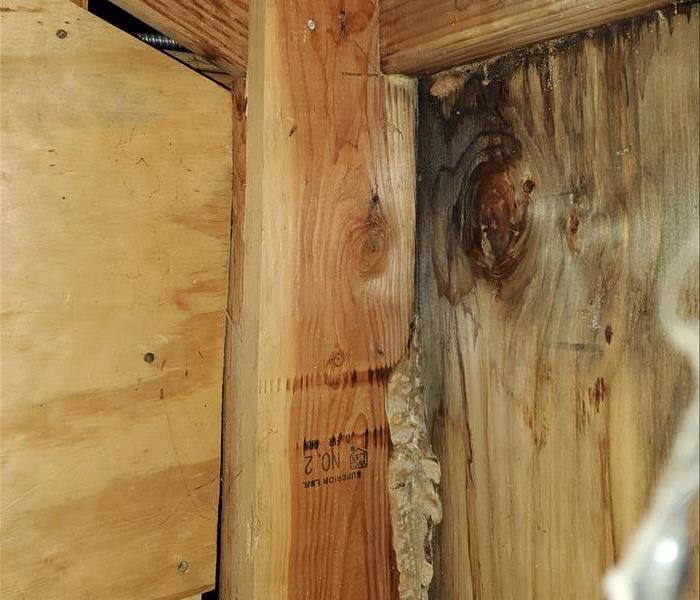 Close-up of mold growing on a wall with dark spots, indicating moisture damage and potential health risks.
Close-up of mold growing on a wall with dark spots, indicating moisture damage and potential health risks.
Every business’s mold damage situation is unique and may require a tailored solution. However, the general mold remediation process remains the same. The steps outlined below represent the “typical” process:
Step 1: Emergency Service
Contact SERVPRO of Northwest Ventura County at 805-507-5507 for immediate assistance.
Step 2: Inspection and Assessment
Our team conducts a thorough evaluation to assess the extent of the mold damage.
Step 3: Mold Containment
We isolate the affected areas to prevent the spread of mold spores.
Step 4: Air Filtration
We use advanced air filtration systems to capture airborne spores and improve air quality.
Step 5: Removing Mold and Mold-Infested Materials
We carefully remove contaminated materials to stop the mold from spreading further.
Step 6: Cleaning Contents and Belongings
All affected items are professionally cleaned and restored to prevent mold growth.
Step 7: Restoration
We restore your property to its original condition, ensuring all mold damage is addressed.
Need Help? Call SERVPRO of Northwest Ventura County
We’re available 24/7, 365 days a year. Call us at 805-507-5507 for fast, professional mold remediation.
Signs of Water-Damaged Walls: When to Call SERVPRO®
2/4/2025 (Permalink)
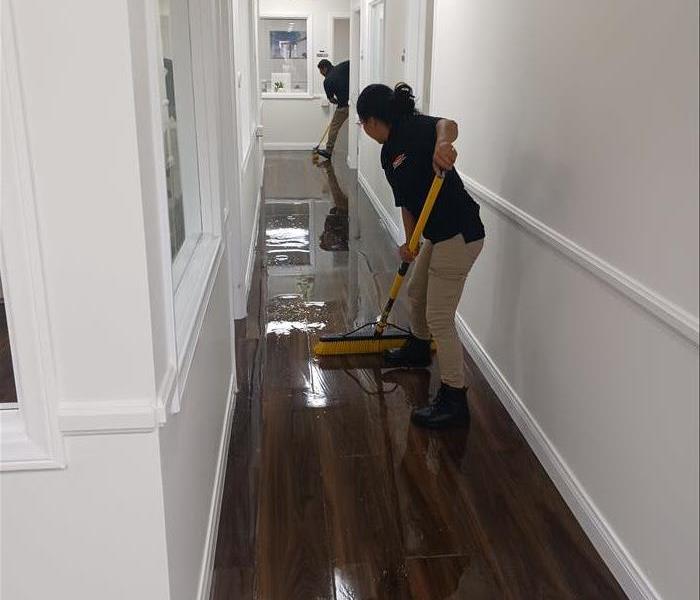 SERVPRO technician working efficiently to clean and restore flooded room, ensuring your property returns to its pre-damage condition quickly and safe
SERVPRO technician working efficiently to clean and restore flooded room, ensuring your property returns to its pre-damage condition quickly and safe
Water damage can appear in many forms, from a simple leaky sink to the devastation of a flooded basement or hurricane damage. If you notice water damage in your walls, it’s essential to assess the situation to determine whether professional help is needed. While smaller issues can sometimes be addressed independently, larger water damage situations require expert cleanup and restoration services, like those provided by SERVPRO®.
Even if you’re unsure of the severity, it's always a good idea to seek a professional opinion to ensure that no hidden damage is overlooked. Here are key signs of water-damaged walls that might require a call to SERVPRO®:
- Mold Growth: Mold can develop in as little as 24 to 48 hours after water damage. If you see mold spots, especially in hidden areas like basements or attics, it’s important to act quickly.
- Musty Odors: Damp or musty smells, especially around basements or older appliances, indicate the presence of water damage and mold.
- Peeling Paint or Wallpaper: When water seeps into the walls, it can cause paint or wallpaper to peel or bubble due to loss of adhesion.
- Discolored or Warped Walls: Water-damaged walls may become discolored, warped, cracked, or even soft to the touch.
- Wet or Squishy Carpets: If the carpet near the walls feels damp or squishy, water may have soaked through the wall and affected the flooring.
- Rising Utility Bills: A sudden increase in your water or energy bill could indicate hidden leaks within the walls.
- Rotted Wood: Wood in or around your walls may become rotted and weakened from prolonged exposure to water.
- Efflorescence: White, chalky stains on walls, a sign of moisture that has evaporated and left behind salts.
When to Call a Professional
If you suspect water damage, it’s always safest to call a professional restoration company like SERVPRO®. Even if the damage seems minor, hidden issues such as contamination, mold, or structural weaknesses could present a bigger problem than you realize.
While DIY cleaning may seem like a cost-saving option, improperly addressing water damage can lead to more extensive damage and health risks, such as airborne bacteria or mold growth. SERVPRO® professionals have the expertise and industrial-grade equipment to handle such situations safely and effectively, preventing further damage and minimizing health hazards.
Storm Damage? SERVPRO of Northwest Ventura County is Ready to Help!
1/3/2025 (Permalink)
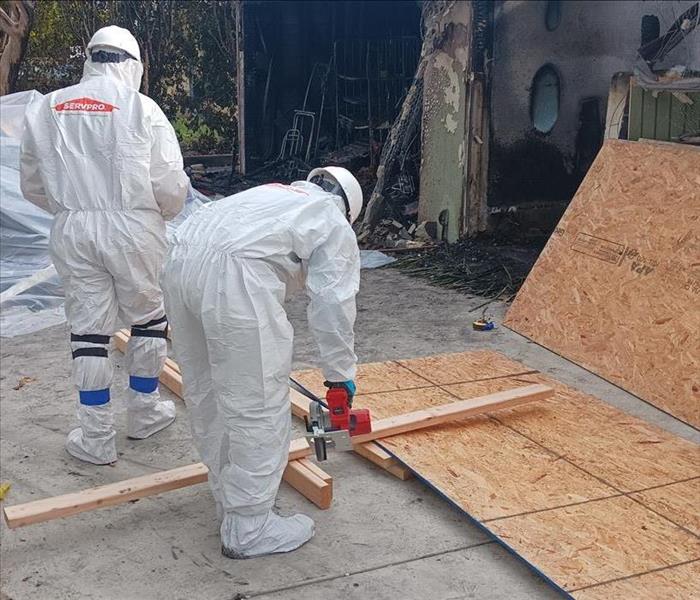 SERVPRO technicians begin board-up services to secure a property and prevent further storm damage.
SERVPRO technicians begin board-up services to secure a property and prevent further storm damage.
At SERVPRO of Northwest Ventura County, we understand that storms can cause significant and often overwhelming damage to your home or business. The effects of a storm can be both immediate and long-lasting, and it’s crucial to act quickly to minimize further destruction. That's why our dedicated technicians are always on stand-by, ready to respond to any emergency, big or small.
As a Family Owned and Operated business, we take pride in providing personalized, high-quality service to our community. Our team works directly with your insurance company to ensure a seamless and hassle-free restoration process. We are Licensed, Bonded, and Insured, so you can trust that you’re in safe hands with SERVPRO of Northwest Ventura County.
Signs of Storm Damage to Look Out For:
Storm damage can affect a wide range of areas inside and outside your property. If you notice any of the following signs, it’s important to get professional help right away:
- Ceilings with a “wet” appearance: This can indicate water damage, which could be a result of leaks from the roof or windows.
- Damaged or missing shingles on your roof: Missing or damaged roofing materials can expose your home to further water damage.
- Mold growth on walls or ceilings: A musty, damp smell is often the first sign of mold, which thrives in wet environments after a storm.
- Peeling interior paint: Excess moisture can cause paint to peel or bubble, a sign of water infiltration.
- Fallen large branches: Heavy winds or storms can cause branches or trees to fall on your roof, leading to potential structural damage.
- Leaks around the home: Water seeping in through windows, doors, or the foundation can cause long-term damage if not addressed immediately.
If you notice any of these signs after a storm, SERVPRO of Northwest Ventura County is here to assist you with prompt, professional storm damage restoration services. Our team is trained to handle everything from roof damage to mold remediation and water damage, restoring your property as quickly as possible.
Don’t wait for the damage to get worse! Call us today, and we’ll help you get back to normal after a storm.
Fire Restoration 12/2024
12/19/2024 (Permalink)
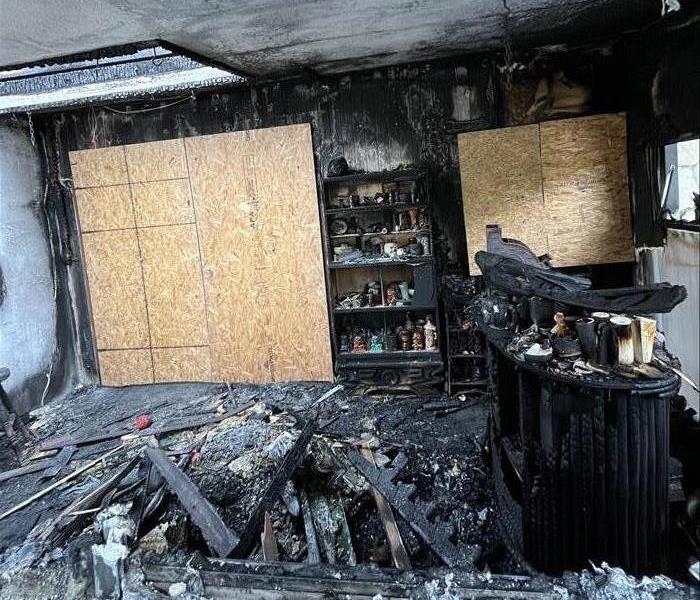 Fire that affected a home visited by our SERVPRO office.
Fire that affected a home visited by our SERVPRO office.
Experiencing a fire can be devastating. Beyond the immediate flames, your home likely faces a cascade of challenges: smoke damage, soot residue, and significant water damage from firefighting efforts.
At SERVPRO®, our specialized teams are trained to navigate the complexities of fire restoration, guiding you through every step of the recovery process. Each situation is unique, but our approach remains consistent:
Immediate Action: When disaster strikes, contact us promptly. Our experts will quickly assess the situation, gathering crucial information to mobilize the necessary equipment and resources for a swift response.
Thorough Evaluation: We conduct a comprehensive inspection to pinpoint the extent of fire, smoke, and water damage. This meticulous assessment forms the foundation of a tailored restoration plan.
Emergency Protection: To safeguard your property from further harm, we swiftly address critical issues like broken windows, damaged roofs, and compromised walls with emergency board-up and roof-tarping services.
Water Mitigation: Water removal is paramount. Our teams utilize advanced techniques to extract excess water and employ powerful dehumidifiers and air movers to expedite the drying process, minimizing secondary damage.
Smoke and Soot Remediation: We utilize specialized equipment and techniques to eliminate smoke and soot residue from all surfaces, including ceilings, walls, and personal belongings.
Cleaning and Odor Control: Our focus extends beyond cleaning – we aim for complete restoration. We employ a range of cleaning methods to revitalize your belongings, while advanced air scrubbers and fogging equipment effectively neutralize lingering odors.
Comprehensive Restoration: The final phase involves meticulous restoration, ranging from minor repairs like drywall replacement and painting to more extensive reconstruction projects. Our goal is to return your home to its pre-fire condition, providing you with peace of mind and a sense of normalcy.
Mold and Water Damage Restoration: A Comprehensive Approach
7/18/2024 (Permalink)
Water damage can have far-reaching consequences for indoor environments, often leading to mold growth if not addressed promptly and effectively. Mold thrives in damp, moist conditions, making water-damaged areas particularly susceptible to contamination. As such, mold and water damage restoration require a comprehensive approach that addresses both the immediate effects of water damage and the potential long-term consequences of mold growth. In this blog, we'll explore the interconnected nature of mold and water damage restoration and discuss strategies for a comprehensive restoration approach.
Understanding the Link Between Water Damage and Mold Growth
Water damage provides the ideal conditions for mold growth, creating a humid environment where mold spores can germinate and proliferate rapidly. When water infiltrates indoor spaces due to flooding, leaks, or plumbing failures, it can penetrate building materials such as drywall, wood, and insulation, creating hidden pockets of moisture conducive to mold growth. Without prompt mitigation and remediation, water-damaged areas can become breeding grounds for mold, leading to contamination of indoor surfaces and compromising indoor air quality.
The Importance of Swift Water Damage Mitigation
Effective water damage restoration begins with swift mitigation efforts to remove excess water and moisture from indoor spaces. This involves extracting standing water using pumps or wet/dry vacuums, drying affected surfaces with industrial-grade dehumidifiers and air movers, and implementing measures to prevent further water intrusion. Swift mitigation helps minimize the extent of water damage, reduces the risk of mold growth, and sets the stage for effective mold remediation.
Mold Remediation: Addressing Hidden Contamination
Even after water damage has been mitigated, residual moisture and dampness may persist in building materials, creating favorable conditions for mold growth. As such, mold remediation is an essential component of comprehensive water damage restoration. Mold remediation involves identifying and removing mold-contaminated materials, cleaning and disinfecting affected surfaces, and implementing measures to prevent mold recurrence. Professional mold remediation specialists such as SERVPRO of Northwest Ventura County have the expertise and equipment to conduct thorough inspections, assess the extent of mold contamination, and implement targeted remediation strategies to restore indoor environments to a safe and healthy condition.
Integrated Restoration Solutions
To ensure a comprehensive approach to mold and water damage restoration, it's essential to integrate mitigation, remediation, and restoration efforts seamlessly. This may involve:
- Assessment and Inspection: Conducting thorough assessments to identify water damage and mold contamination, including hidden areas such as behind walls, under flooring, and within air ducts.
- Swift Mitigation: Implementing rapid water extraction and drying techniques to remove excess moisture and prevent mold growth.
- Professional Remediation: Engaging certified mold remediation specialists to conduct comprehensive mold inspections, remediate contamination, and restore indoor environments to preloss conditions.
- Repair and Restoration: Repairing and restoring water-damaged materials and structures to their original state, ensuring structural integrity and aesthetic appeal.
Prevention and Maintenance
In addition to remediation efforts, proactive prevention and maintenance measures are essential for preventing future water damage and mold growth. This may include regular inspections, maintenance of plumbing and HVAC systems, implementation of moisture control measures, and establishment of effective drainage and waterproofing systems.
DIY Tips for Preventing Water Damage
6/12/2024 (Permalink)
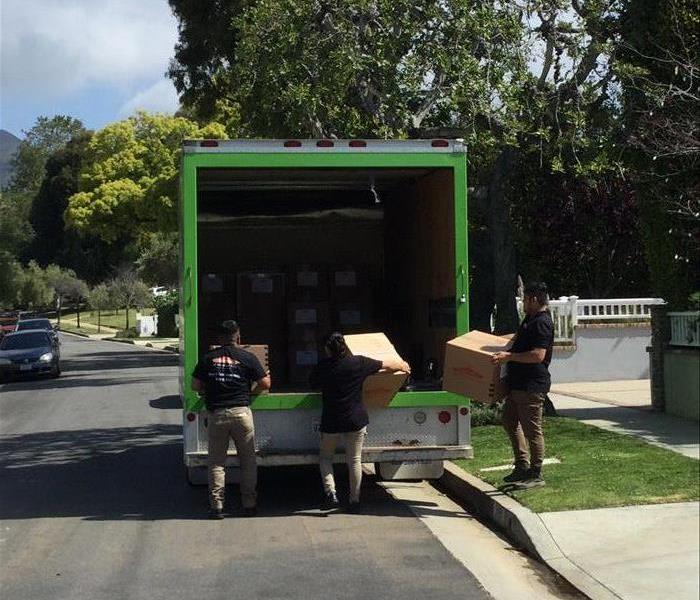 Our team is available 24/7 to assist you in restoring your home to its pre-damaged condition quickly and efficiently.
Our team is available 24/7 to assist you in restoring your home to its pre-damaged condition quickly and efficiently.
Water damage can wreak havoc on your home, causing structural issues, mold growth, and expensive repairs. However, with a few simple do-it-yourself (DIY) tips, you can prevent water damage and safeguard your property. At SERVPRO®, we're committed to helping homeowners protect their investments, and we're here to share some practical advice to keep your home safe and dry.
- Inspect and Maintain Your Roof: Regularly inspect your roof for signs of damage such as missing shingles, cracked flashing, or deteriorating seals around vents and chimneys. Address any issues promptly to prevent water from seeping into your home and causing interior damage.
- Clean Gutters and Downspouts: Clogged gutters and downspouts can lead to water overflow, which can damage your roof, siding, and foundation. Clean gutters regularly to ensure proper drainage, especially during the fall when leaves and debris accumulate.
- Check for Plumbing Leaks: Inspect plumbing fixtures, pipes, and appliances for leaks regularly. Look for signs of water stains, drips, or moisture buildup under sinks, around toilets, and behind appliances like dishwashers and washing machines. Repair any leaks promptly to prevent water damage and mold growth.
- Monitor Water Pressure: High water pressure can stress plumbing pipes and fixtures, leading to leaks and bursts. Install a pressure gauge on your main water line to monitor water pressure regularly. If the pressure exceeds recommended levels (usually between 40-80 psi), consider installing a pressure regulator to protect your plumbing system.
- Seal Windows and Doors: Check the seals around windows and doors for cracks or gaps that could allow water to penetrate your home during heavy rain or storms. Use weatherstripping or caulk to seal any gaps and prevent water infiltration.
- Maintain Your Landscape: Proper landscaping can help prevent water from pooling around your home's foundation. Ensure that the ground slopes away from your house to encourage water runoff and prevent water from seeping into your basement or crawlspace.
- Install a Sump Pump: If your home is prone to basement flooding, consider installing a sump pump to remove excess water and prevent water damage. Regularly test your sump pump to ensure it's working correctly, especially before the rainy season.
- Insulate Pipes: During cold weather, frozen pipes can burst and cause significant water damage. Insulate exposed pipes in unheated areas such as basements, attics, and crawlspaces to prevent freezing and potential leaks.
By following these DIY tips for preventing water damage, you can protect your home and avoid costly repairs. However, if you do experience water damage despite your best efforts, don't hesitate to contact SERVPRO for professional water damage restoration services. Our team is available 24/7 to assist you in restoring your home to its pre-damaged condition quickly and efficiently. Stay proactive and safeguard your home against water damage—it's a decision you won't regret.
The impact of wildfires on air quality and respiratory health
4/19/2024 (Permalink)
As a trusted leader in the restoration and cleaning industry, SERVPRO® is committed to not only restoring homes and businesses but also providing valuable information to our community. Today, we delve into a critical topic that affects us all – the impact of wildfires on air quality and respiratory health.
Wildfires are becoming increasingly prevalent, wreaking havoc on landscapes and communities. Beyond the immediate threat of flames, the long-lasting effects on air quality can significantly impact our respiratory health. Understanding these effects is crucial for safeguarding the well-being of ourselves and our loved ones.
Particulate Matter and Respiratory Distress
When wildfires occur, they release a multitude of pollutants into the air, including particulate matter (PM). These tiny particles, often too small to be seen with the naked eye, can penetrate deep into the lungs, causing respiratory distress. Individuals with pre-existing conditions such as asthma, bronchitis, or chronic obstructive pulmonary disease (COPD) are particularly vulnerable.
Health Risks of Wildfire Smoke
Wildfire smoke is a complex mixture of gases and fine particles, which can include carbon monoxide, volatile organic compounds, and irritant gases. Prolonged exposure to these pollutants can lead to short-term health effects such as eye and throat irritation, coughing, and difficulty breathing. In the long term, it can exacerbate chronic respiratory conditions and increase the risk of heart attacks.
Importance of Indoor Air Quality
During wildfire events, staying indoors may provide some protection from outdoor pollutants. However, it is crucial to maintain indoor air quality. Close windows and doors, use air purifiers with HEPA filters, and avoid activities that can introduce indoor pollutants.
SERVPRO's Expertise in Air Quality Restoration
In the aftermath of a wildfire, the road to recovery involves not only rebuilding but also addressing the lingering effects on indoor air quality. Our skilled technicians at SERVPRO are equipped to assess and mitigate the damage caused by smoke and soot. From HVAC system cleaning to thorough cleaning of affected surfaces, we ensure that your home or business is not only restored aesthetically but also in terms of air quality.
Proactive Measures for Future Protection
As wildfires become a recurring threat, taking proactive measures becomes paramount. Stay informed about air quality conditions in your area, have an emergency plan in place, and invest in air quality monitoring devices to ensure the safety of your indoor environment.
The impact of wildfires on air quality and respiratory health is a matter of growing concern. By staying informed and taking proactive steps, we can minimize the risks associated with wildfire-induced air pollution. At SERVPRO, we are dedicated to not only restoring but also educating our community to create a safer, healthier environment for all.
Emergency Response Planning for Storms
4/9/2024 (Permalink)
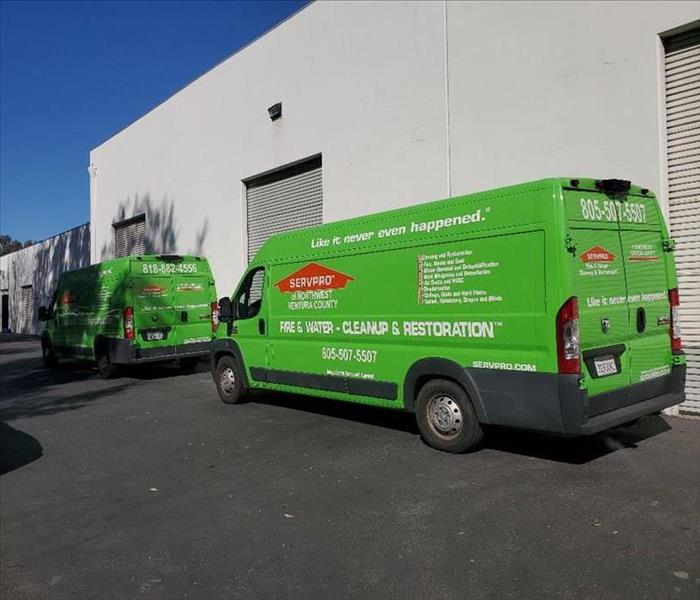 Be prepared before the storm hits!
Be prepared before the storm hits!
As we've seen time and time again, Mother Nature can be unpredictable and unforgiving, especially when it comes to storms. Whether it's a hurricane, tornado, or severe thunderstorm, the key to minimizing damage and keeping your loved ones safe is preparation. At SERVPRO®, we understand the importance of having a solid emergency response plan in place before disaster strikes. That's why we're here to share some essential tips for creating an effective emergency response plan for storms.
- Assess Your Risks: Start by identifying the types of storms that are common in your area. Is your region prone to hurricanes, tornadoes, or heavy snowfall? Understanding your specific risks will help you tailor your emergency response plan accordingly.
- Create a Communication Strategy: Communication is key during any emergency situation. Establish a communication plan with your family members, neighbors, and coworkers. Make sure everyone knows how to reach each other in case of an emergency and establish a designated meeting point if you need to evacuate.
- Build an Emergency Kit: Put together an emergency kit that includes essential items such as non-perishable food, water, flashlights, batteries, a first aid kit, and any necessary medications. Keep your kit in a designated location that is easily accessible to everyone in your household.
- Secure Your Property: Take steps to protect your home and property from storm damage. Trim trees and bushes, secure outdoor furniture and loose objects, and consider installing storm shutters or reinforcing your windows and doors.
- Know Your Evacuation Routes: Familiarize yourself with the evacuation routes in your area and have a plan in place for how you will evacuate if necessary. Keep in mind that roads may become congested during an evacuation, so plan ahead and leave early if instructed to do so.
- Stay Informed: Stay informed about weather conditions in your area by monitoring local news and weather reports. Invest in a weather radio or download a weather app to receive real-time updates and alerts.
- Have a Restoration Plan: Despite your best efforts, storms can still cause damage to your property. Have a restoration plan in place with trusted professionals like SERVPRO who can quickly respond to mitigate damage and help you get back on your feet.
By taking the time to create an emergency response plan for storms, you can help protect yourself, your loved ones, and your property from the devastating effects of severe weather. Remember, it's better to be over-prepared than caught off guard when disaster strikes. Stay safe and be proactive in your storm preparedness efforts!
The Hidden Dangers of Mold in Air Ducts
3/13/2024 (Permalink)
Let's discuss a silent intruder that might be lurking in your home – mold in your air ducts. Since our air ducts are out of sight and out of mind, most of us don't give much thought to our HVAC systems until something goes wrong, but understanding the hidden dangers of mold in air ducts is crucial for maintaining a mold neutral living environment.
The Sneaky Culprit
Mold is a persistent little troublemaker that can find its way into your air ducts without much fanfare. It thrives in dark, damp environments, making your HVAC system an ideal breeding ground. From airborne spores, it settles in the ducts, and can spread throughout your home or business, forming colonies that can lead to a variety of issues.
Reduced Efficiency
Mold growth in air ducts can also hinder the efficiency of your HVAC system. Mold buildup restricts airflow, making your system work harder to maintain the desired temperature. This not only increases energy consumption but can also lead to premature wear and tear on your HVAC components.
Unpleasant Odors
Ever noticed a musty odor when your HVAC system kicks in? That's a telltale sign of mold in your air ducts. Mold produces volatile organic compounds (VOCs) that contribute to that distinctive, unpleasant smell. Eliminating the mold means saying goodbye to those unwelcome odors.
Prevention and Remediation
The good news is that preventing and addressing mold in your air ducts is well within reach. Regular HVAC maintenance, including cleaning and inspecting your ducts, can help identify and eliminate mold before it becomes a serious problem. Additionally, investing in quality air filters and maintaining proper ventilation in your home can go a long way in keeping mold at bay. Remember, mold thrives on moisture, so minimize the moisture in your home and air ducts as much as possible.
When to Call the Pros
If you suspect mold in your air ducts or have noticed a decline in indoor air quality, it's time to call in the professionals. SERVPRO® specializes in mold remediation and can safely and effectively eliminate mold from your air ducts, restoring a clean and mold neutral environment for you and your family.
Don't let mold hide in the shadows of your air ducts! By understanding the hidden dangers and taking proactive steps, you can ensure your HVAC system operates efficiently while keeping your home's air quality top-notch. Remember, a healthy home is a happy home!
10 Simple Steps to Protect Your Home Against Water Damage
2/14/2024 (Permalink)
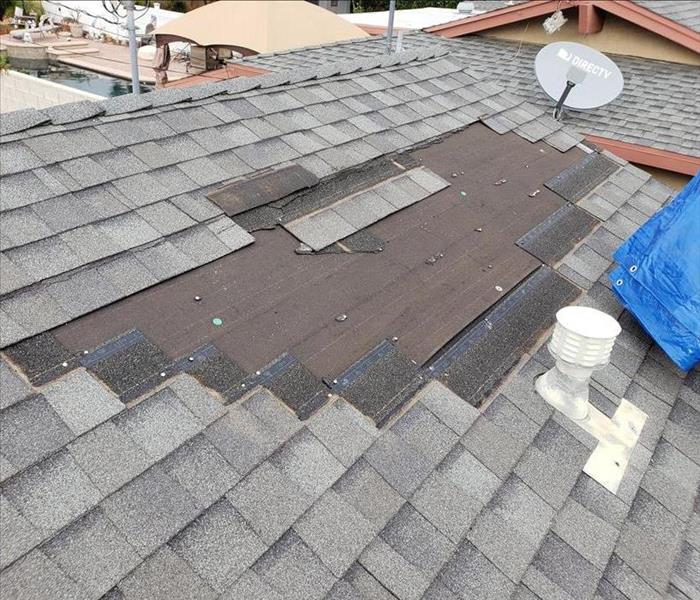 Regularly inspect your roof for missing or damaged shingles.
Regularly inspect your roof for missing or damaged shingles.
Water damage poses a significant threat to the integrity and safety of your home. As a seasoned professional in the restoration industry, we've witnessed the impact of water damage firsthand and understand the importance of proactive measures in protecting your home. Here are 10 practical and straightforward ways to protect your home against water damage:
- Regular Maintenance Checks
Schedule routine inspections of your home's plumbing, roof, and gutters. Look for leaks, cracks, or signs of wear and tear. Promptly address any issues to prevent potential water intrusion.
- Maintain Gutters and Downspouts
Clear debris from gutters and downspouts regularly to ensure proper drainage. Clogged gutters can lead to water overflow and cause damage to your home's foundation.
- Proper Landscaping
Ensure the landscape around your home slopes away from the foundation. Proper grading helps direct water away from the house, preventing water accumulation around the foundation.
- Seal Cracks and Gaps
Seal any cracks or gaps in walls, windows, and doors to prevent water infiltration during heavy rains or storms. Use caulk or weatherstripping to seal these vulnerable areas.
- Check Appliances Regularly
Inspect appliances like washing machines, dishwashers, and refrigerators for leaks or worn-out hoses. Replace hoses and connections if necessary and address any leaks promptly.
- Maintain Sump Pump
If your home has a sump pump, ensure it is in good working condition. Test it periodically to ensure proper functioning, especially before the rainy season.
- Install Water Detection Devices
Consider installing water detection devices or alarms in areas prone to water damage, such as basements or near water heaters. These devices can alert you to potential leaks or water accumulation.
- Monitor Water Pressure
Excessive water pressure can strain pipes, leading to leaks or bursts. Use a pressure gauge to monitor and regulate water pressure, keeping it within recommended levels.
- Inspect the Roof
Regularly inspect your roof for missing or damaged shingles. Repair or replace damaged roofing materials to prevent water from seeping into your home.
- Protect Outdoor Faucets
If the temperature drops below freezing, remember to insulate outdoor faucets and pipes to prevent freezing and potential bursts during winter months. Disconnect and drain hoses before winter weather sets in.
By implementing these simple yet effective measures, you can significantly reduce the risk of water damage to your home. Regular maintenance, proactive inspections, and addressing issues promptly are key to protecting your home against potential water-related disasters. Remember, a little prevention goes a long way in protecting your home and preserving its integrity.
 Close-up of mold growing on a wall with dark spots, indicating moisture damage and potential health risks.
Close-up of mold growing on a wall with dark spots, indicating moisture damage and potential health risks.





 24/7 Emergency Service
24/7 Emergency Service




